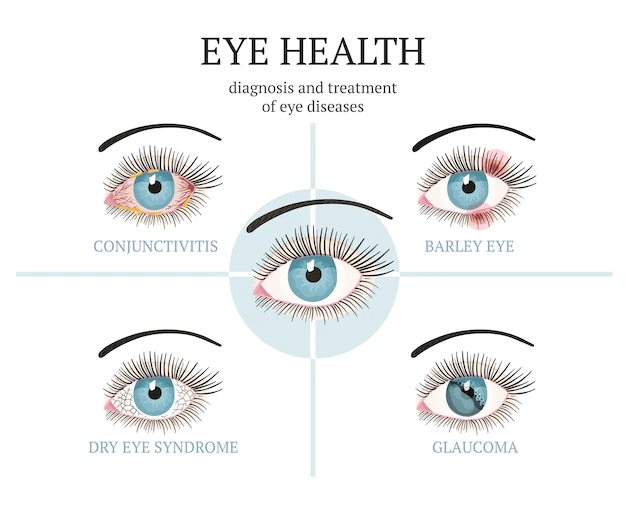Image Source: FreeImages
Eye diseases are a common issue for many people in the United States, and can range from mild to severe. The most common eye diseases in America include glaucoma, cataracts, diabetic retinopathy, age-related macular degeneration, and dry eye. Each of these diseases can cause varying levels of vision loss, and some can even lead to complete blindness. Fortunately, there are steps that can be taken to prevent or lessen the severity of these conditions. This article will provide an overview of the five most common eye diseases in America, as well as the steps that can be taken to protect your eyes and vision.
Glaucoma
Glaucoma is a disease that typically develops slowly over time, and can lead to permanent vision loss if left untreated. It is the second-leading cause of blindness in the world, and the leading cause of blindness among people aged 55 or older. Glaucoma is caused by an increase in intraocular pressure (IOP), which damages the optic nerve and can lead to vision loss. The risk factors for glaucoma include increased age, certain eye diseases and conditions, certain medication use, and family history. Symptoms can include headache, eye pain, blurred vision, and seeing halos or shadows around lights. If glaucoma is detected early, treatment options include eye drops, medications, and surgery. If glaucoma is left untreated, it can cause the visual field to shrink and lead to permanent vision loss.
Cataracts
Cataracts are a common eye disease that is caused by a clouding of the lens within the eye. It is the leading cause of vision loss and blindness in the world. The risk factors for cataracts include age, certain eye diseases and conditions, certain medication use, and being in professions that involve exposure to high levels of glare and ultraviolet light.
Cataracts can develop in one or both eyes and be either congenital or acquired later in life. Symptoms of cataracts include blurry vision, difficulty reading, seeing halos around lights, and changed colors. Cataracts can be surgically removed and replaced with an intraocular lens implant. The length of time for a cataract surgery depends on the seriousness and progression of the disease it self. Always speak with a profession about treatment options for cataracts.
Diabetic Retinopathy
Diabetic retinopathy is an eye disease that is most common among people living with diabetes. It is the leading cause of vision loss among people with diabetes. It can lead to blindness if left untreated. Diabetic retinopathy is caused by damage to the blood vessels in the retina, which can lead to areas of bleeding or swelling in the retina. The risk factors for diabetic retinopathy include high blood sugar levels, long-term diabetes, and high blood pressure. Symptoms of diabetic retinopathy can include blurry vision, black or gray spots in the visual field, and sudden pulses of light in one or both eyes. Diabetic retinopathy is treatable, but can lead to severe visual loss if left untreated.
Age-related Macular Degeneration
Age-related macular degeneration (AMD) is a degenerative eye disease that is the leading cause of vision loss among people aged 60 and older. It is the most common cause of blindness among older adults in the United States. AMD is caused by the deterioration of the macular, which is the part of the retina responsible for detailed vision.
The risk factors for AMD include aging, certain eye diseases and conditions, family history, and cigarette smoking. Symptoms of AMD include distorted or blurred vision, loss of central vision, and missing colors. Age-related macular degeneration is not a disease that can be cured, but there are treatment options that can slow down the progression of the disease.
Dry Eye
Dry eye is a common eye disease that causes a reduction in the amount of tears produced, which leads to discomfort and blurry vision. It is the leading cause of vision impairment among the working-age population. The risk factors for dry eye include certain eye diseases and conditions, certain medication use, and being aged 40 or older. Symptoms of dry eye include dry or itchy eyes, difficulty reading, blurred vision, and seeing halos around lights. Dry eye can be treated with daily eye drops, artificial tears, lifestyle changes, and in some cases, surgery.
Prevention and Treatment
Glaucoma : If you are at a high risk for glaucoma, speak with your eye doctor about starting treatment early. If you have diabetes, it’s especially important to have regular eye exams to catch glaucoma early and prevent it from getting worse.
Cataracts : If you are at a high risk for cataracts, take preventative steps to avoid overexposure to UV light (wear sunglasses, avoid tanning beds, etc.), eat a healthy diet rich in antioxidants and minerals, and exercise regularly.
Diabetic Retinopathy : To reduce your risk of diabetic retinopathy, keep your blood sugar controlled and avoid tobacco use. If you have diabetes, be sure to get regular eye exams to monitor your retinas for signs of damage.
Age-related Macular Degeneration : Eat a healthy diet rich in vitamins A and C, get enough Vitamin E and zinc, and exercise regularly. Smoking cigarettes and being overly stressed can increase your risk of AMD. Getting regular eye exams can help you catch any signs of AMD early and slow its progression.
Dry Eye : Follow a healthy diet, get plenty of sleep, and exercise regularly. Avoid smoke and dry environments. Also, be sure to use eye drops as prescribed, even if you don’t feel like you have symptoms.
Conclusion
Eye diseases are a common issue for many people in the United States, and can range from mild to severe. While some of these diseases can be prevented, others can progress without any signs or symptoms. The most common eye diseases in America include glaucoma, cataracts, diabetic retinopathy, age-related macular degeneration, and dry eye. Each of these diseases can cause varying levels of vision loss, and some can even lead to complete blindness. Fortunately, there are steps that can be taken to prevent or lessen the severity of these conditions.











